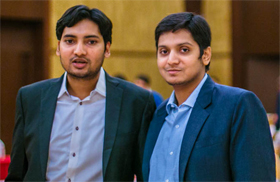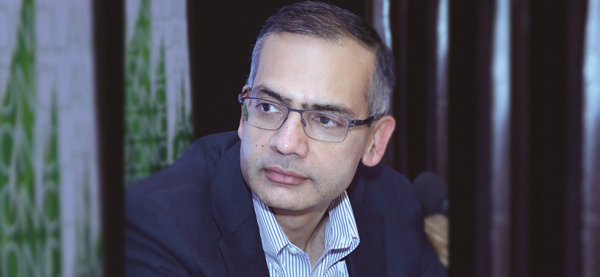Rikant Pitti, COO and CO-Founder, EaseMyTrip, spoke to TourismFirst about various aspects of the GST roll out, the future direction of online and some noticeable changes in the Indian traveller’s habits. Excerpts:
First of all, please give us your perspective on the impact of GST. Will it affect the pace at which discounts and sales are being offered?
 GST will have a noteworthy impact on each and every industry of India and affect every consumer to a certain level. It will also fill the loopholes of the present tax system. Implemented to boost the economy of India, this will simplify and amalgamate the indirect taxes in all the states of India. The biggest thing is that it will help in improving Indian economy and make the process of levying indirect taxes more modernized and updated. Where some products and services will see a raise in rates, some will be more economical. In fact, flight tickets in economy class have also become cheaper in compare to earlier. However, travel industry is not going to be much affected with the implementation of GST. As traveling has become a necessity now, people are not going to compromise on that.
GST will have a noteworthy impact on each and every industry of India and affect every consumer to a certain level. It will also fill the loopholes of the present tax system. Implemented to boost the economy of India, this will simplify and amalgamate the indirect taxes in all the states of India. The biggest thing is that it will help in improving Indian economy and make the process of levying indirect taxes more modernized and updated. Where some products and services will see a raise in rates, some will be more economical. In fact, flight tickets in economy class have also become cheaper in compare to earlier. However, travel industry is not going to be much affected with the implementation of GST. As traveling has become a necessity now, people are not going to compromise on that.
As far as the affect on the discounts and sales is concerned, it is too early to decide or give any statement over this.
Would you say that the rollout could have been more structured in terms of rates? What can we do to take on the lower tax rates that our neighboring countries have to offer?
Till now, taxes were levied separately on products and services that often used to be very complex and very few people were able to understand them. GST is a great move of Indian government as it will be payable at the final consuming point and no one will have any issue on calculating it (once they understand it properly). The rollout in terms of the rates is totally structured as per my opinion. All seven key segments to be impacted by GST have been selected very carefully. Despite calling it one nation – one tax, government of India has given the states a freedom to decide the GST rates of state as per their convenience and I think it is a wonderful decision. As far as matter of neighboring countries is concerned, we should not try to compete with them in terms of taxes. Each country has its own condition and requirements. It works as per that and I personally feel we are good.
Google recently released a report according to which the Indian travel market will touch the $48 billion mark by 2020. Are OTAs infrastructurally prepared for such an influx in traffic?
Indian travel market is growing consistently and OTAs have managed themselves very well till this time. If we talk about the last few years, there has been a huge expansion in the Indian travel market. Both the inbound and outbound travel markets of India are seeing percentage growth over previous year. And OTAs have managed themselves very well so far. The figures shared by Google will reach to that point in the coming 3 years and even if certain OTAs are not prepared to manage this influx of traffic, they will be ready by that time. We are expecting this traffic to come from Tier-3 cities of India and getting us ready to connect with the users and customers in their preferred languages. In fact, online travel industry of India is moving towards the advancement and approaching innovative techniques to handle more traffic.
How has mobile penetration been shaping up? Which sector would you say will be most impacted by mobile penetration? Tell us about the impact of personalisation in the Indian context.
Mobile penetration rate is increasing in India. As per a report released by GSMA in June 2016, there were about 616 million unique mobile users in India. Out of which, there are 238 million smart phone users. Urban users of India consider mobile phone their primary source of using internet. They use it for booking tickets, planning holidays, ordering food and shopping. Increasing power of technology, mobile apps and technical advancement are allowing the marketers to use mobile phones as great source to reach more number of customers and provide them the best deals. Each e-commerce industry will be affected by the mobile penetration but penetration of mobile has given the travel industry a great boost in terms of traffic.
Personalization is making a great impact. In fact personalization influences the customers to avail or purchase a product or service. The rising importance and impact of personalization emerges from the fact that it clears uncertainty and establishes a one to one connection. Through the activities of mobile users, we are trying to identify the consumer behavior. For example- if a person shows his interest in certain products or services, e-commerce companies try showing or offering them the same.
What are some new trends that you are seeing in the Indian traveler?
Indian travelers are becoming used to traveling now days. Current travel industry of India is confronting a huge number of holidaymakers due to increasing spending capacity of consumers. Earlier where they were more interested in saving money, now they want to it spend on their vacations. Taking a trip has become an important part of their life now and they love exploring new places. Due to not having enough leaves, first they prefer to visit nearby tourist places and short-haul destinations. After exploring enough of neighboring places, they plan for long-haul destinations. They love to take a break from their work but initially don’t visit places that can make hole in their pocket. This is why; Indian tourists firstly prefer to go destinations like Thailand, Singapore, Bali and Dubai and then look for places to travel in Europe or USA. If we talk about few years back, there were very less number of travelers who used to travel by flights or stay at luxury hotels but things are totally different now. Today’s Indian travelers are not ready to compromise with their luxury. Trend has been changed and foreign tours and luxurious stays have become regular thing. We are seeing a new phase of Indian travelers who are passionate about holidaying and well-versed with the ongoing changes in the industry.
What would you say are some of the key drivers that have fuelled the online travel space?
Online travel industry is a faster way to plan a trip. You have a smart-phone with internet and you are all set to go for a journey following few simple steps. This industry is transparent in terms of rates and services. You can compare the prices among huge options available with various OTAs and book as per your comfort and convenience. The advancement of technology is playing a vital role in this expansion of online travel space and customers have the ease of booking hotels, flights, and holiday packages without losing the comfort of your home or office. Understanding today’s aspirations, OTAs are including those trends that influence more techno savvy travelers. A fast growing trend that industry is seeing is the mixing business with luxury and OTAs are taking care of it very well by offering corporate travel segment. Call to action through social media is another key driver to stimulate online travel space.
With increased competition and reduced margins, do you see consolidation, like the MakeMyTrip-Ibibo merger, in the online travel space, in the near future?
When two big players of Indian travel industry were working so aggressively on reduced margins, great discounts and huge cash-back, this merger was meant to happen. In fact, I feel that this merger will reduce the price war between OTAs that have been adversely affecting the margins so far.




































